The Chalcolithic, a name derived from the Greek: χαλκός khalkós, "copper" and from λίθος líthos, "stone" or Copper Age, also known as the Eneolithic or Aeneolithic, is an archaeological period that researchers now regard as part of the broader Neolithic. Earlier scholars defined it as a transitional period between the Neolithic and the Bronze Age. In the context of Eastern Europe, archaeologists often prefer the term "Eneolithic" to "Chalcolithic" or other alternatives.

Pottery is the process and the products of forming vessels and other objects with clay and other ceramic materials, which are fired at high temperatures to give them a hard and durable form. Major types include earthenware, stoneware and porcelain. The place where such wares are made by a potter is also called a pottery. The definition of pottery, used by the ASTM International, is "all fired ceramic wares that contain clay when formed, except technical, structural, and refractory products." In art history and archaeology, especially of ancient and prehistoric periods, "pottery" often means vessels only, and sculpted figurines of the same material are called "terracottas".
Major innovations in materials technology
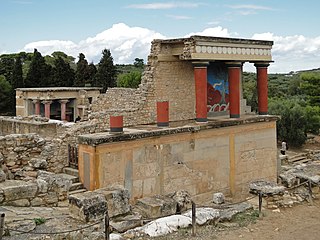
Knossos is the largest Bronze Age archaeological site on Crete and has been called Europe's oldest city.
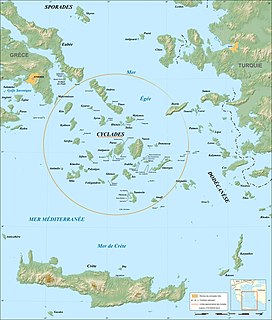
Cycladic culture was a Bronze Age culture found throughout the islands of the Cyclades in the Aegean Sea. In chronological terms, it is a relative dating system for artifacts which broadly complement Helladic chronology and Minoan chronology (Crete) during the same period of time.

A vase is an open container. It can be made from a number of materials, such as ceramics, glass, non-rusting metals, such as aluminium, brass, bronze, or stainless steel. Even wood has been used to make vases, either by using tree species that naturally resist rot, such as teak, or by applying a protective coating to conventional wood or plastic. Vases are often decorated, and they are often used to hold cut flowers. Vases come in different sizes to support whatever flower it is holding or keeping in place.
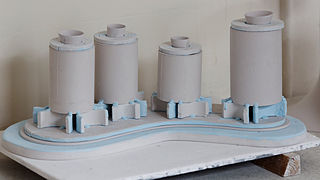
Slip casting, or slipcasting, is a ceramic forming technique for pottery and other ceramics, especially for shapes not easily made on a wheel. In this method, a liquid clay body slip is poured into plaster moulds and allowed to form a layer, the cast, on the inside walls of the mould. The process usually takes at least 24 hours per piece. It gives very precise and consistent shapes, and is now the most common technique used for commercial mass-produced pottery, although it began as a technique for fine pottery such as European porcelain in the 1750s, and Chinese Jingdezhen porcelain considerably earlier.

A mountain in north-central Crete, Mount Juktas, also spelled Iuktas, Iouktas, or Ioukhtas, was an important religious site for the Minoan civilization. Located a few kilometers from the palaces of Knossos and Fourni and the megaron at Vathypetro, Mount Juktas was the site of an important peak sanctuary in the Minoan world. At the base of Juktas, at Anemospilia, is a site that has suggested to some that the Minoans practiced human sacrifice, but the evidence is currently somewhat in question.

Studio pottery is pottery made by professional and amateur artists or artisans working alone or in small groups, making unique items or short runs. Typically, all stages of manufacture are carried out by the artists themselves. Studio pottery includes functional wares such as tableware and cookware, and non-functional wares such as sculpture, with vases and bowls covering the middle ground, often being used only for display. Studio potters can be referred to as ceramic artists, ceramists, ceramicists or as an artist who uses clay as a medium.

Minoan pottery has been used as a tool for dating the mute Minoan civilization. Its restless sequence of quirky maturing artistic styles reveals something of Minoan patrons' pleasure in novelty while they assist archaeologists in assigning relative dates to the strata of their sites. Pots that contained oils and ointments, exported from 18th century BC Crete, have been found at sites through the Aegean islands and mainland Greece, on Cyprus, along coastal Syria and in Egypt, showing the wide trading contacts of the Minoans.

Vasiliki is the name of a village in the municipality of Ierapetra, in the prefecture of Lasithi, on Crete, and the name of the nearby Minoan archeological site. The site took its name from the village.
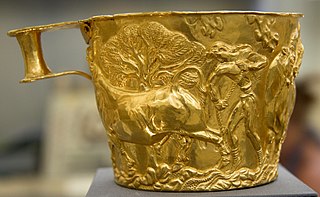
Vaphio, Vafio or Vapheio is an ancient site in Laconia, Greece, on the right bank of the Eurotas, some five miles south of Sparta. It is famous for its tholos or "beehive" tomb, excavated in 1889 by Christos Tsountas. This consists of a walled approach, about 97 feet long, leading to a vaulted chamber some 33 feet in diameter, in the floor of which the actual grave was cut.

Mycenaean pottery is the pottery tradition associated with the Mycenaean period in Ancient Greece. It encompassed a variety of styles and forms including the stirrup jar. The term "Mycenaean" comes from the site Mycenae, and was first applied by Heinrich Schliemann.
A processional walkway is a ceremonial walkway in use since ancient times. Common functions of a processional walkway are for religious, governmental or celebratory purposes.
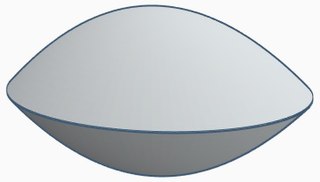
Lentoid is a geometric shape of a three-dimensional body, best described as a circle viewed from one direction and a convex lens viewed from every orthogonal direction. It has no strict mathematical definition, but may be described as the volume enclosed within overlapping paraboloids.

Trapeza, Crete is a Neolithic and Bronze Age sacred cave on the island of Crete in Greece. Some of the Bronze Age pottery finds at Trapeza are similar to specimens recovered at Knossos and Vasiliki.
Magasa is a Neolithic settlement on the eastern part of the island of Crete in present-day Greece. Magasa is notable as a Neolithic Cretan settlement for some use of large room sizes in its multi-roomed residences. The ben-and-but style of housing design with some use of mud-dried brick has been noted as similar to that found in Neolithic Knossos.
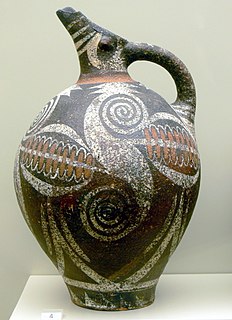
Kamares ware is a distinctive type of Minoan pottery produced in Crete during the Minoan period, dating to MM IA. By the LM IA period, or the end of the First Palace Period, these wares decline in distribution and "vitality". They have traditionally been interpreted as a prestige artifact, possibly used as an elite table-ware.

But and ben is an architectural style for a simple building, usually applied to a residence. The etymology is from the Scots term for a two-roomed cottage. The term describes a basic design of "outer room" conjoined with "inner room" as a residential building plan; the outer room, used as an antechamber or kitchen, is the but, while the inner room is the ben. The word but, here, comes from Early Scots/Middle English "bouten" "outside", and ben from ES/ME "binnen", "inside".

China painting, or porcelain painting, is the decoration of glazed porcelain objects such as plates, bowls, vases or statues. The body of the object may be hard-paste porcelain, developed in China in the 7th or 8th century, or soft-paste porcelain, developed in 18th-century Europe. The broader term ceramic painting includes painted decoration on lead-glazed earthenware such as creamware or tin-glazed pottery such as maiolica or faience.
















